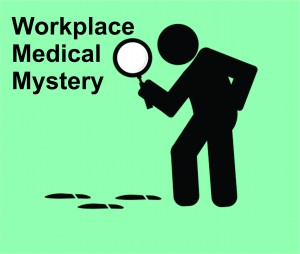Workplace Medical Mystery: What is causing a recycling worker’s respiratory distress?
Posted on by Joe worked at a metal recycling facility in Nevada. His typical job duties included operating a material handler to load scrap metal into a shear for crushing. During his shift at the recycling facility, Joe looked up to see a plume of thick yellow smoke swirl around a pile of scrap metal and was suddenly overcome with shortness of breath, coughing, chest pressure, and eye irritation. He thought about grabbing a fire extinguisher but then ran away from the smoke until the air cleared. Joe’s supervisor saw that he was in distress and called 9-1-1. When medical help arrived, Joe’s blood oxygen saturation was 87% and increased to 94% with supplemental oxygen (normal saturations are within the range of 95% to 100% while breathing room air).
Joe worked at a metal recycling facility in Nevada. His typical job duties included operating a material handler to load scrap metal into a shear for crushing. During his shift at the recycling facility, Joe looked up to see a plume of thick yellow smoke swirl around a pile of scrap metal and was suddenly overcome with shortness of breath, coughing, chest pressure, and eye irritation. He thought about grabbing a fire extinguisher but then ran away from the smoke until the air cleared. Joe’s supervisor saw that he was in distress and called 9-1-1. When medical help arrived, Joe’s blood oxygen saturation was 87% and increased to 94% with supplemental oxygen (normal saturations are within the range of 95% to 100% while breathing room air).
Emergency response personnel transported him to a local hospital. Although alert, he had an elevated heart rate and difficulty breathing and quickly developed respiratory failure with inadequate blood oxygen levels. He was intubated and placed on mechanical ventilation roughly 20 min after arriving at the hospital. He was also administered inhaled nitric oxide to improve oxygenation. X-rays of his chest showed fluid in the lungs (pulmonary edema), and bloodwork revealed an acid-base disorder (respiratory and metabolic acidosis). Additional tests led to the diagnosis of acute respiratory distress syndrome or ARDS. Joe’s supervisor remembered that the system for scanning incoming metal for radioactive material had been malfunctioning. He relayed this information to the paramedics.
Prior to this sudden onset of respiratory failure, Joe’s only chronic medical problems were high blood pressure and a heart rhythm disorder called atrial fibrillation. He was a nonsmoker and had no past history of lung disease. His hobby was woodworking. His wife reported that he had stripped and restored an antique dining table the previous weekend.
What was causing Joe’s illness?
Check back on Friday for the next installment of Workplace Medical Mysteries to see what is making Joe sick. Think you know? Tell us what you think it is in the comment section below.
R. Reid Harvey, DVM, MPH, is an Epidemiologist in the NIOSH Respiratory Health Division.
Michelle R. Martin, MS, is a Health Communications Specialist in the NIOSH Respiratory Health Division.
Julie Tisdale-Pardi, MA, is the Coordinator of the NIOSH Science Blog.
This blog is part of the NIOSH Workplace Medical Mystery Series. The names and personal details of the characters are fictitious and do not represent an actual person or persons.
Posted on by

